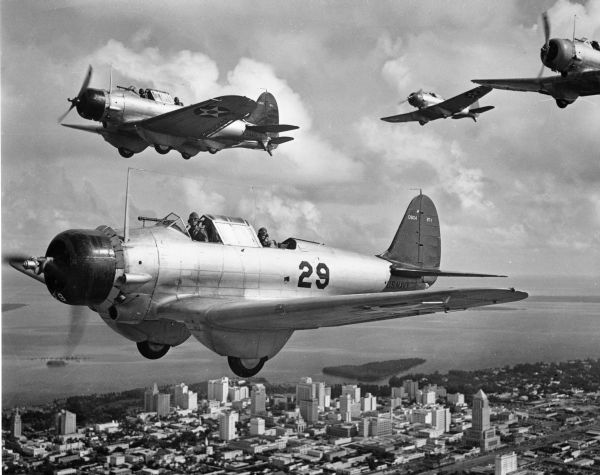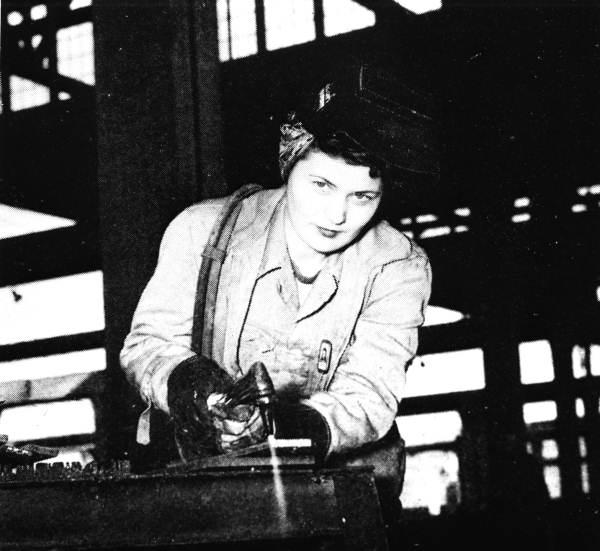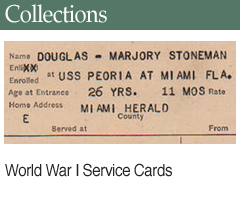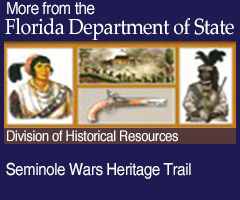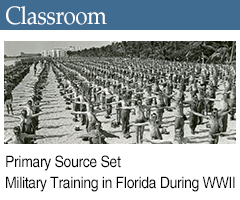Guide to Military Records and the Wartime Experience
at the State Archives of Florida
World War II, 1939-1945
Contents
When the United States entered World War II on December 8, 1941, Florida was still one of the least populated southern states, mostly rural and agricultural. However, the war efforts at home and abroad would drastically change it forever.
Florida's large swaths of land, warm climate and extensive coastline made it ideal for training hundreds of thousands of military recruits, particularly in aviation and amphibious landing operations. In just a few years, the federal government established more than 170 military installations of various sizes, including major bases like Camp Blanding, which became Florida's fourth largest city during the war.
Of the 16 million Americans who served in the war, more than 250,000 were Floridians, and thousands more contributed to the war effort at home. They volunteered for civil defense tasks like patrolling the coastline and watching the skies for enemy aircraft. Families conserved food and collected scrap metal and other materials to be recycled into goods for the war effort. Agriculture became more important than ever, as did the state's shipbuilding industry.
As the U.S. economy and industry boomed, women found opportunities to work in jobs previously believed to be "man's work" in shipyards, welding shops and farms. Women also served the armed forces in support positions. While women were expanding their roles in the workforce, Black Americans continued to experience segregation and racism. Black servicemen were assigned to all-Black units, lived in separate quarters and served almost exclusively in non-combat support roles. By the end of the war, many were serving in combat roles but only after Black leaders such as Floridians Mary McLeod Bethune and A. Philip Randolph pressured the Roosevelt administration to order the changes.
The State Archives has a variety of records that document Florida's involvement in the Second World War and the experiences of Florida's citizens at the time. The records include traditional military records such as rosters and casualty card files, as well as state agency administrative records and personal papers such as scrapbooks, photographs and correspondence.
Government Records
S406
Florida Governor Holland
Correspondence 1941-1945
60.5 cubic feet
Spessard Lindsey Holland was Florida’s 28th governor, elected in 1940. His administration was primarily concerned with World War II and coordinating Florida's defense effort with the federal government. This series contains Governor Holland’s correspondence that reflects the official, constitutional and political duties of the Office of the Governor. The series consists mainly of incoming and outgoing correspondence filed by general subject area, agency or organizational name, or county name.
S417
Florida. State Defense Council
Financial Ledgers, 1941-1945
5 volumes
Frederick P. Cone, Florida’s 27th governor, created the State Defense Council in November 1940 to direct a concerted effort leading toward total war preparedness for Florida. It was comprised of twelve divisions: Industry and Material Resources, Labor and Personnel, Civil Protection, Fire Protection and Water Supply, Agriculture, Food, Health and Housing, Communications and Transportation, Power and Fuel, Finance and Budget, Home Community Service, and Information, Education and Morale. This series contains the Council’s ledger books that document various financial activities. One ledger records orders and payments to the Council for county maps; the remaining four record payment of expenses incurred, including travel, office supplies and telephone and telegraph services.
S419
Florida. State Defense Council
Subject Files, 1940-1946
31 cubic feet
This series contains State Defense Council subject files that provide information on the activities of the Council and its officers. Letters, publications, reports, resolutions, maps and charts from local, state and federal agencies detail defense issues affecting the council from its creation in 1940 to its dissolution after the war. Correspondence, conference proceedings and various publications represent all twelve divisions of the council and reveal the objectives and functions of defense projects in the state. The series also documents the military service and civilian defense activities of Florida women. A scrapbook entitled "Fore and Aft" details the collection of scrap metal in Florida during the war with newspaper clippings, photographs and newsletters. In addition, a collection of maps marks the placement of dim-out lights in Florida by county.
S506
Florida. State Defense Council
Minutes, 1941-1945
.25 cubic foot
The series consists of the minutes of the State Defense Council from January 1941 through February 1944. The minutes document topics discussed, decisions made and actions taken by the council relating to the civil defense effort in Florida during World War II.
S1042
Florida. State Board of Conservation
Emergency Coordinator of Mines Herman Gunter Records, 1935-1945
1 cubic foot
During World War II, the federal government ordered minerals such as phosphate, limestone, dolomite, gypsum and kaolin to be reserved for war use. To coordinate the production of these vital minerals, former State Geologist Herman Gunter was appointed Emergency Coordinator of Mines in 1941. This series primarily contains correspondence to and from Gunter before and during his time as Emergency Coordinator.
S1131
Florida. State Defense Council
Scrapbooks, 1941-1944
13 cubic feet
The series contains scrapbooks of newspaper clippings relating to the activities of the State Defense Council from April 1941 to July 1944.
S1205
Florida. State Defense Council
Posters, 1942-1944
100 items
The series contains printed posters issued during the World War II by various federal agencies. The posters portray a variety of subjects, including conservation and rationing, espionage and counterespionage, war bonds, war production, health and the allies. Also included are the famous "Four Freedoms" posters by Norman Rockwell.
S1316
Florida. State Defense Council, Division of Transportation and Communication
Florida Motorized Civil Unit Records, 1940-1943
1.25 cubic feet
Prior to U.S. involvement in the war, Guy H. Allen, the Tampa branch manager of American Oil Company, was worried that Florida's long coastline left it vulnerable to saboteur units and spies, so he created the Florida Motorcycle Corps in August 1940 under the sponsorship of local chambers of commerce. With the creation of the State Defense Council in 1941, the corps achieved official status as an escort for military truck convoys under the Council’s Division of Transportation and Communication. However, wartime pressures on the "home guard" eventually took their toll as men dropped out to enroll in military service and as shortages of rubber and gasoline mounted. This series contains correspondence, organization files, memoranda, news clippings and county files of the Florida Motorized Civil Unit and later of the Subdivision of Motor Escort and Transportation. Also included are the papers of Guy Allen relating to the creation of this unit and his plans to build motorized cavalry units behind enemy lines.
S1420
Florida State Guard
Roster, 1941-1951
.5 cubic foot
The Florida Legislature established the Florida Defense Force, later called the Florida State Guard, in 1941 as a state funded military force to replace the National Guard if the federal government deployed it abroad. This series contains the roster of men who served in the Florida Defense Force and the Florida State Guard between 1941 and 1951. The information provided includes the serviceman’s name, the place where he enlisted and the unit in which he served.
S1432
Florida. Military Department
World War II Casualty Card Files, 1950
1 cubic foot
This series contains cards that the Military Department assembled and used as a central file to track the military casualties from Florida during World War II. Each card has the name, rank and last known hometown of each casualty. Also included is how the service member died (i.e., battle death, sickness, accident, etc.), the location by theater of action (i.e., European, African, South Pacific, etc.), and the authority for listing the casualty. In addition, there is information about persons listed as missing or those confirmed as prisoners of war.
S1475
Florida Industrial Commission
War Manpower Commission Reports, 1943-1945
2.5 cubic feet
The Florida Industrial Commission served as the recruitment and placement service for vital war industries throughout World War II. It divided the state into War Manpower Commission Administrative Areas headquartered in Jacksonville, Miami, Orlando, Panama City and Tampa, and Labor Market Areas in those cities, as well as in Gainesville, Key West, Lakeland, Pensacola and West Palm Beach. These offices reported to state and federal agencies regarding the demand, supply and availability of labor, actual and expected in-migration of labor, and the consequent effect on existing community facilities and training agencies. The reports in this series consist of State Director's reports, field operating reports from the Administrative Areas, labor market developments reports and demand and supply supplements from designated Labor Market Areas. Also included are 1943 labor market surveys for Pensacola and Gainesville.
S1476
Florida Industrial Commission
Reference Files, 1936-1953
4 cubic feet
This series contains reference files of the Florida Industrial Commission related to its Unemployment Compensation and Employment Service Divisions. Included are bulletins, reports and memoranda from the U.S. Social Security Board, U.S. Bureau of Employment Security, U.S. Employment Service, War Manpower Commission and U.S. Bureau of Labor Statistics. The unemployment compensation files document the development of the program in Florida and other states under the guidance of the U.S. Social Security Board's regulations. There are also conference reports and proceedings of the Interstate Conference of Employment Security Agencies. The labor files document labor markets, labor supply and wages during World War II at state, regional and national levels. Wage reports document the type of industries and wages in Florida after the war.
S1477
Florida Industrial Commission
Subject Files, 1937-1949
5 cubic feet
The series contains subject files that consist of bulletins, memoranda, correspondence, manuals and reports from the U.S. Social Security Board, U.S. Bureau of Employment Security, U.S. Bureau of Labor Statistics and the War Manpower Commission. The bulk of the materials are related to the operations of the Florida State Employment Service, the U.S. Employment Service and the War Manpower Commission. The series documents the mobilization of labor for defense industries.
Personal and Family Papers
M84-6
Tommon Tinney, Aviation Photographs, 1941-1945
13 photographs
This collection contains photographs of aviation activities during World War II. Photographs include Jim Fair flying several planes, including the B-17. Images depict planes on the ground and flying over Cape Canaveral, Florida and Panama.
M87-16
Langford Family Papers, 1935-1945
1 folder
This collection contains items related to World War II including several ration cards and stamps, a news clipping advertising DDT and a 1945 postcard to a German POW in a camp near Jacksonville.
M87-39
F. Arlie Rhodes Papers, 1850-1980
3.25 cubic feet
F. Arlie Rhodes, a native of Woodville, Florida, served in the U.S. Naval Reserve from 1942 to 1946, spending 20 months of active service in the South Pacific. This collection contains correspondence, photographs, genealogical materials, newspaper clippings, cassette recordings and other items. Of interest are letters and items related to Rhodes' experience in World War II.
M99-3
World War II War Ration Books, 1943
3 items
These ration coupon booklets belonged to Dale Lawrence Canfield, Elaine R. Canfield, and Herbert H. Canfield of Rockledge, Florida. The United States Office of Price Administration issued the booklets, entitled "War Ration Book Four," in 1943.
N2003-5
Talmadge L. Buller World War II Reminiscences, 1999
29 pages
Talmadge L. Buller served as a Private First Class of Company C, 124th Infantry of the 31st Infantry Division during World War II. During his tour of duty, Buller fought in the Battle of Colgan Woods in the Philippine Islands in May 1945. This collection contains Buller’s reminiscences of events during the battle, written in 1999. The paper provides a brief introduction and history of the battle, in which he argues that although there were heavy casualties, the battle itself was of no strategic value. The information Buller provides in his reminiscences comes from his own research, recollections and through conversations with fellow soldiers at reunions. Buller provides a detailed account of his fellow soldiers and officers and the difficult events they faced.
N2004-5
William Thomas Cash Papers, 1918-1951 (bulk 1936-1947)
2.25 cubic feet
William Thomas Cash was Florida’s first State Librarian, appointed in 1927. This collection contains personal correspondence, articles on Florida history, financial papers and news clippings that Cash accumulated and wrote while he was State Librarian. Most of the materials date from the Great Depression and World War II and document ways in which the Library Board and Cash dealt with financial difficulties during this time.
N2004-6
Craig Mills Papers, 1935-2002
8 cubic feet
Barber Craig Mills was a highly decorated U.S. Army Officer with the 771st Tank Battalion during World War II, which fought in France, Belgium, the Netherlands and Germany. This collection contains correspondence, news clippings, subject files and photographs documenting Mills’ career as an educator, soldier, state employee, consultant and public speaker. Included are letters from his brother, E.S. (Gene) Mills, Jr., who served in the U.S. Army Air Corps during the 1940s, and letters from various soldiers of the 771st Tank Battalion and their families. Other materials of interest include presentations, photographs, correspondence and clippings of Mills' career as a soldier in World War II; and materials related to the history of the 771st Tank Battalion.
N2004-13
World War II Posters, 1944-1945
3 items
This series contains printed posters that various federal agencies issued during the Second World War. The posters portray a variety of subjects, including conservation and rationing, espionage and counterespionage, war bonds, war production, health and the allies.
N2006-1
William Paul Shelley Papers, 1914-2007
4.5 cubic feet
William Paul Shelley, Jr., born in 1914, in Liberty County, Florida, entered the U.S. Army on active duty as a 1st Lt. assigned to Field Artillery at Fort Bragg, North Carolina on January 13, 1942. He was later assigned to the 77th Infantry Division, 306th Field Artillery Battalion and served in the Pacific Theatre throughout World War II. During his active duty service, Shelley obtained the ranks of Captain and Major. After the war, Shelley had a long career in politics and law. This collection contains business, personal, political and military records documenting the life, careers and activities of Shelley and his wife, Erin Clark Shelley. There is correspondence from Shelley to his parents while he was serving in World War II that provides insight into his career in the U.S. Army Reserve Corps, and the photographs include images of Shelley during World War II.
N2007-4
World War II Memoir of Navy Cross Recipient Dale M. Leslie, 1942
1 compact disk
Dale M. Leslie was a native of Madison County, Florida. Leslie entered Naval aviation training in May 1941 after attending college. He selected the U.S. Marine Corps as the service in which to take his commission and flew dive bomber and fighter aircraft in the Pacific campaigns. On September 27, 1942, Leslie provided close air support to a Marine unit trapped by a significantly larger Japanese force and supervised the retrieval of every Marine of the infantry unit. For his actions, Leslie earned the Navy Cross, the nation's second-most senior decoration for valor in combat. This collection consists of an audio recording and photographs relating to Dale M. Leslie's combat activities during World War II. The recording is of Leslie’s address to the Men's Methodist Fellowship in Madison on November 2, 1962 in which he recounts the actions for which he earned the Navy Cross and relates his adventures after being shot down in the air battles for Guadalcanal, Solomon Islands in 1942. The photographs include images of Colonel Leslie and some of his squadron mates.
N2008-11
Byrd, Bernard, Bradford, Taylor and Tilden Family Papers, ca. 1918-2000
1 cubic foot
The Byrd, Bernard, Bradford, Taylor and Tilden families came to Leon County, Florida, in the early 1800s and eventually became linked through marriage. This collection contains letters, photographs, business records and other papers documenting these families over much of the 20th century. Among the papers are World War II ration booklets for the Taylor family; Robert Taylor's World War II military identification card; correspondence from the Office of Price Administration regarding the rationing of items at the Byrd family grocery store; and mileage ration identification folders, weekly operations reports and tire inspection reports for the Byrd grocery store vehicles.
N2012-1
Beatrice Swain Szumanski, Riddle Field Pilot Training Papers, ca. 1943-1945
.10 cubic foot
Riddle Field, near Clewiston, Florida, was used for training U.S. Army Air Corps/Army Air Forces cadets and British Royal Air Force cadets during World War II. This collection contains photographs and papers from Beatrice Swain Szumanski's time assisting at Riddle Field for British Royal Air Force cadet pilot training. Included are group photographs of graduating classes (Course 17, Course 19 and Course 22); a group photo of instructors and officers; images of RAF cadet Alan Davidson in the cockpit and with Swain; a certificate of appreciation for her assistance "to the British Mission in North America;" and an invitation to the graduation ceremony for the cadets of Course 23 on June 16, 1945.
N2013-1
Charles E. Tribble Papers, 1940-1956, bulk 1942-1945
3 cubic feet
In 1942, Dr. Charles Emerson Tribble of DeLand received a Lieutenant Commander's commission in the Medical Corps of the U.S. Navy Reserve and served as a surgeon until 1945. After several shore station assignments in Florida, he transferred to hospital operations in various locations of the South Pacific in 1943. He later transferred to the hospital ship USS Solace (AH-5) in 1944. While aboard the Solace, Dr. Tribble cared for victims of the battles of Iwo Jima and Okinawa in 1945. This collection documents the life and career of Dr. Charles E. Tribble. The collection also contains Navy orders and routine correspondence providing a general outline of Dr. Tribble's experiences with the Navy.
N2014-11
Michael J. Drake, Sarasota County Aviation Collection, ca. 1910-1950
1 cubic foot
Michael J. Drake was a historian of historic airports and aviation activities in southwest Florida. This collection consists of Drake’s accumulated research materials and includes photocopies of news clippings, military reports, photographs, ephemera and correspondence. Much of the collection documents the history of airports around Sarasota and Arcadia, including the Sarasota-Bradenton International Airport, which was known as Sarasota Army Air Field during World War II. The bulk of the material pertains to military aviation. Some correspondence dates from the 1930s and 1940s and documents the actions of military personnel, but most of the letters are between Drake and former military members who shared their stories and sometimes photographs and documents with him. The collection also includes three rolls of microfilm containing declassified photographs, reports and other records from Sarasota Army Air Field, and three films with footage of Sarasota Army Air Field featuring personnel and training activities during its final year as a military facility in 1945.
N2016-3
Saulson Family Papers, 1943-circa 2000s, bulk 1940s
1 folder, 2 compact disks
During World War II, William Feiven Saulson served in the United States Army Air Corps as a bomber pilot assigned to the 301st Bomber Group 419th Squadron. He became a highly decorated veteran. His wife, Lila Mae, worked as an American Red Cross volunteer at veterans' hospitals. This collection contains scans of the daily letters exchanged between Saulson and his wife during World War II, as well as a copy of the certificate given to William listing his military awards and Bronze Service Stars.
N2017-92
Claude Pepper Letters and Transcripts, 1941, 1950
1 folder
Claude Pepper was a Congressman from Florida. He served in the U.S. Senate from 1936 to 1951, and the U.S. House of Representatives from 1963 until 1989. This collection includes three transcripts of Senator Pepper’s radio addresses, dated January 22, January 25 and January 26, 1941, that are about Pepper's public feelings towards World War II and democracy. One letter is from William Thomas Cash dated February 1, 1941, regarding the speech transcripts. The second letter, dated March 11, 1950, is to Dr. Dorothy Dodd regarding Pepper’s support of the State Library and Dr. Dodd's efforts and assistance in his campaign for re-election.
N2017-146
William Russell O'Neal Papers, 1924, 1940-1945
1 cubic foot
William Russell O'Neal settled in Orlando, Florida in 1886. There he was the author of two local newspaper columns, "The Observer" and "Memoirs of a Pioneer," for the Orlando Sentinel-Star. These columns covered a variety of topics, such as the early development of the city of Orlando and its buildings, people and events. He also discussed daily events on a local level and worldwide events during World War II, giving insight into what was happening on the home front during the war. This collection contains typescripts of O'Neal's newspaper columns between the years 1940 and 1945. Filed with the typescripts are various letters, postcards and other correspondence from readers of his columns.
N2018-10
John Kent Folsom Papers, 1941-1947, bulk 1943
1 cubic foot
John Kent Folsom was a veteran of the Second World War and a Tallahassee-based lawyer. Registering for the Army in 1942, he trained at Camp Crowder in Missouri, Camp Murphy in Florida and Camp Davis in North Carolina. Servicemen at the Signal Corps Replacement Training Center at Camp Crowder specialized in communication trades, serving as wiremen, radio operators, message center men, clerks, cooks and aircraft warning technicians. Folsom trained in radio before switching to telephone. This collection contains correspondence sent to Folsom during his training, photographs and other personal records. The papers provide valuable documentation of a segment of North Florida culture during the war.
N2018-22
George Leroy Chamberlin Scrapbook, 1940-1942
1 volume
George Leroy Chamberlin served in the U.S. Army Air Corps from 1940 to 1945. Though he started his army career in the Panama Canal Zone, Chamberlin also served at Eglin Airfield and Fort Walton Beach in Florida and at Warner Robbins Air Force Base in Georgia. Chamberlin prepared this scrapbook to memorialize his early years of military service prior to and during World War II. It includes news clippings, cards, letters, photographs and other mementos. Chamberlin includes descriptors throughout the scrapbook to provide more context. The scrapbook gives a concise glimpse into the life of a soldier in the U.S. Army during World War II.

 Listen: The Blues Program
Listen: The Blues Program